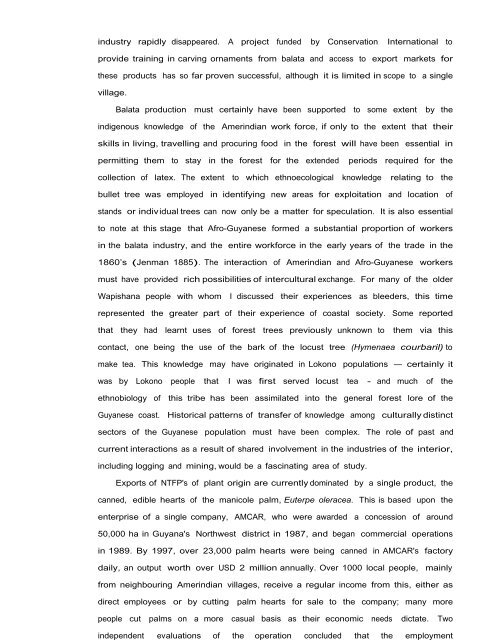Ethnoecology, Resource Use, Conservation And Development In A ...
Ethnoecology, Resource Use, Conservation And Development In A ...
Ethnoecology, Resource Use, Conservation And Development In A ...
You also want an ePaper? Increase the reach of your titles
YUMPU automatically turns print PDFs into web optimized ePapers that Google loves.
industry rapidly disappeared. A project funded by <strong>Conservation</strong> <strong>In</strong>ternational to<br />
provide training in carving ornaments from balata and access to export markets for<br />
these products has so far proven successful, although it is limited in scope to a single<br />
village.<br />
Balata production must certainly have been supported to some extent by the<br />
indigenous knowledge of the Amerindian work force, if only to the extent that their<br />
skills in living, travelling and procuring food in the forest will have been essential in<br />
permitting them to stay in the forest for the extended periods required for the<br />
collection of latex. The extent to which ethnoecological knowledge relating to the<br />
bullet tree was employed in identifying new areas for exploitation and location of<br />
stands or individual trees can now only be a matter for speculation. It is also essential<br />
to note at this stage that Afro-Guyanese formed a substantial proportion of workers<br />
in the balata industry, and the entire workforce in the early years of the trade in the<br />
1860’s (Jenman 1885). The interaction of Amerindian and Afro-Guyanese workers<br />
must have provided rich possibilities of intercultural exchange. For many of the older<br />
Wapishana people with whom I discussed their experiences as bleeders, this time<br />
represented the greater part of their experience of coastal society. Some reported<br />
that they had learnt uses of forest trees previously unknown to them via this<br />
contact, one being the use of the bark of the locust tree (Hymenaea courbaril) to<br />
make tea. This knowledge may have originated in Lokono populations — certainly it<br />
was by Lokono people that I was first served locust tea - and much of the<br />
ethnobiology of this tribe has been assimilated into the general forest lore of the<br />
Guyanese coast. Historical patterns of transfer of knowledge among culturally distinct<br />
sectors of the Guyanese population must have been complex. The role of past and<br />
current interactions as a result of shared involvement in the industries of the interior,<br />
including logging and mining, would be a fascinating area of study.<br />
Exports of NTFP's of plant origin are currently dominated by a single product, the<br />
canned, edible hearts of the manicole palm, Euterpe oleracea. This is based upon the<br />
enterprise of a single company, AMCAR, who were awarded a concession of around<br />
50,000 ha in Guyana's Northwest district in 1987, and began commercial operations<br />
in 1989. By 1997, over 23,000 palm hearts were being canned in AMCAR's factory<br />
daily, an output worth over USD 2 million annually. Over 1000 local people, mainly<br />
from neighbouring Amerindian villages, receive a regular income from this, either as<br />
direct employees or by cutting palm hearts for sale to the company; many more<br />
people cut palms on a more casual basis as their economic needs dictate. Two<br />
independent evaluations of the operation concluded that the employment


